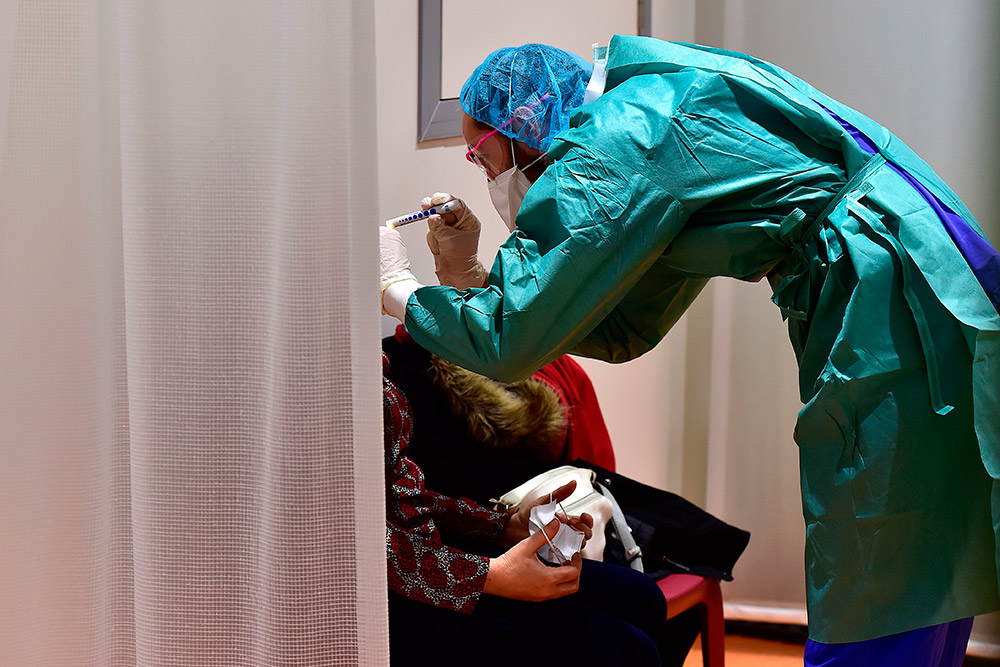大多数不幸感染新冠病毒的人,病毒只是停留在他们的鼻腔和喉咙,只会引起咳嗽等症状。然而,当病毒到达肺部的时候,情况就开始变得危险了。
七分之一的患者会出现呼吸困难和其他严重并发症,6%的患者会发展为危重症患者。根据上个月发布的《中国—世界卫生组织新型冠状病毒肺炎联合考察报告》,这些患者通常患有呼吸衰竭和其他重要器官衰竭,有的还会出现脓毒性休克。
世卫组织总干事高级顾问布鲁斯·艾尔沃德表示,从轻中症发展到重症可能会 “非常非常快”。艾尔沃德是中国—世界卫生组织新型冠状病毒肺炎联合考察组外方组长,在中国考察了5.6万例病例的数据。自去年12月武汉首次出现新冠肺炎病例以来,新冠肺炎已经导致超过4000人死亡。了解这种疾病的发病过程以及识别高危人群,对于更好地应对这种全球性传染病有着至关重要的作用。
大约10%到15%的轻中症患者会发展为重症患者,而15%到20%的重症患者会发展为危重症患者。高危患者包括60岁及以上的患者以及患有高血压、糖尿病和心血管疾病等既有疾病的患者。
杰弗里·K·陶本伯格对西班牙流感患者的感染情况进行过研究,20多年前还从美国阿拉斯加西北部的永久冻土中挖掘出一具西班牙流感患者的尸体用以研究。陶本伯格称:“从临床表现来看,这种疾病的感染模式与流感没有什么不同。”
新冠肺炎(Covid-19)很可能是通过感染者咳嗽、打喷嚏或呼吸时排出的携带病毒的飞沫来传播的。
最先受感染的一般是鼻部。陶本伯格是美国国家过敏和传染病研究所病毒发病和进化机理部门的负责人,该研究所位于马里兰州贝塞斯达。他表示,新冠病毒一旦进入人体,就会入侵保护着呼吸道的上皮细胞。如果病毒被限制在上呼吸道中,症状通常不会太严重。
但如果病毒沿着气管进入呼吸树和肺组织的外围分支,疾病就可能发展到更严重的阶段。这是因为病毒引发的肺炎会对人体造成直接损害,而人体的免疫反应又会造成二次损害。
陶本伯格说:“一旦发生肺部损伤,人体就会立即尝试修复。” 各种白细胞是最先作出反应的,它们会消灭病原体,并参与修复受损的人体组织。“通常情况下,如果进展顺利,短短几天内就能清除感染。”
陶本伯格指出,在一些更严重的新冠肺炎感染病例中,免疫系统的反应可能过于强烈,导致不仅被病毒感染的细胞被消灭,健康的人体组织也同样被损坏。气管或支气管的上皮如果受损,就可能会丧失一些分泌黏液的保护性细胞,或者丧失将尘垢和呼吸道分泌物清扫出肺部的纤毛。
陶本伯格表示:“这样,人体就无法阻挡病原体进入下呼吸道。”因此,肺部很容易继发侵袭性细菌感染。平时藏匿在鼻腔和喉咙之中的病菌,以及医院里滋生的耐药性细菌——特别是在呼吸机管路和面罩内潮湿的空气中,更容易有细菌滋生——都可能会引发感染。

继发性细菌感染会对患者构成特别严重的威胁,因为它们可能会杀死呼吸道干细胞,而这些干细胞对于人体组织恢复活力至关重要。陶本伯格表示,没有了这些呼吸道干细胞,“就无法修复肺部损伤。”肺部受损会导致人体重要器官缺氧,进而对肾脏、肝脏、大脑和心脏造成损害。
美国国家过敏和传染病研究所的所长高级科学顾问大卫·莫朗说:“当人体遭受非常严重的感染时,所有器官都会开始接连崩溃。一旦过了那个临界点,一切便都开始走下坡路。到了某个时候,就再也无法挽回了。”
美国艾奥瓦城的艾奥瓦大学(University Of Iowa)微生物学和免疫学教授斯坦利·珀尔曼研究冠状病毒已有38年之久。他认为,这个临界点在老年人身上可能也会更早出现,就像小鼠实验中的老年小鼠一样。
然而,即便是原本身体健康的年轻人,也已经有死于新冠肺炎的病例。武汉一位34岁的眼科医生李文亮接受了抗体、抗病毒药物、抗生素和吸氧治疗,还将血液引出体外再经人工肺泵回体内,但最终还是于上月不幸离世。
陶本伯格表示,某些人的基因特征可能是他们更容易受病毒侵袭的原因,具体原因可能是他们的呼吸道上皮细胞中有更多容易与病毒结合的特定形状的蛋白受体。另外,某些人可能有轻微的免疫缺陷或基础疾病相关的其他宿主因素。(财富中文网)
译者:温丹萍
大多数不幸感染新冠病毒的人,病毒只是停留在他们的鼻腔和喉咙,只会引起咳嗽等症状。然而,当病毒到达肺部的时候,情况就开始变得危险了。
七分之一的患者会出现呼吸困难和其他严重并发症,6%的患者会发展为危重症患者。根据上个月发布的《中国—世界卫生组织新型冠状病毒肺炎联合考察报告》,这些患者通常患有呼吸衰竭和其他重要器官衰竭,有的还会出现脓毒性休克。
世卫组织总干事高级顾问布鲁斯·艾尔沃德表示,从轻中症发展到重症可能会 “非常非常快”。艾尔沃德是中国—世界卫生组织新型冠状病毒肺炎联合考察组外方组长,在中国考察了5.6万例病例的数据。自去年12月武汉首次出现新冠肺炎病例以来,新冠肺炎已经导致超过4000人死亡。了解这种疾病的发病过程以及识别高危人群,对于更好地应对这种全球性传染病有着至关重要的作用。
大约10%到15%的轻中症患者会发展为重症患者,而15%到20%的重症患者会发展为危重症患者。高危患者包括60岁及以上的患者以及患有高血压、糖尿病和心血管疾病等既有疾病的患者。
杰弗里·K·陶本伯格对西班牙流感患者的感染情况进行过研究,20多年前还从美国阿拉斯加西北部的永久冻土中挖掘出一具西班牙流感患者的尸体用以研究。陶本伯格称:“从临床表现来看,这种疾病的感染模式与流感没有什么不同。”
新冠肺炎(Covid-19)很可能是通过感染者咳嗽、打喷嚏或呼吸时排出的携带病毒的飞沫来传播的。
最先受感染的一般是鼻部。陶本伯格是美国国家过敏和传染病研究所病毒发病和进化机理部门的负责人,该研究所位于马里兰州贝塞斯达。他表示,新冠病毒一旦进入人体,就会入侵保护着呼吸道的上皮细胞。如果病毒被限制在上呼吸道中,症状通常不会太严重。
但如果病毒沿着气管进入呼吸树和肺组织的外围分支,疾病就可能发展到更严重的阶段。这是因为病毒引发的肺炎会对人体造成直接损害,而人体的免疫反应又会造成二次损害。
陶本伯格说:“一旦发生肺部损伤,人体就会立即尝试修复。” 各种白细胞是最先作出反应的,它们会消灭病原体,并参与修复受损的人体组织。“通常情况下,如果进展顺利,短短几天内就能清除感染。”
陶本伯格指出,在一些更严重的新冠肺炎感染病例中,免疫系统的反应可能过于强烈,导致不仅被病毒感染的细胞被消灭,健康的人体组织也同样被损坏。气管或支气管的上皮如果受损,就可能会丧失一些分泌黏液的保护性细胞,或者丧失将尘垢和呼吸道分泌物清扫出肺部的纤毛。
陶本伯格表示:“这样,人体就无法阻挡病原体进入下呼吸道。”因此,肺部很容易继发侵袭性细菌感染。平时藏匿在鼻腔和喉咙之中的病菌,以及医院里滋生的耐药性细菌——特别是在呼吸机管路和面罩内潮湿的空气中,更容易有细菌滋生——都可能会引发感染。
继发性细菌感染会对患者构成特别严重的威胁,因为它们可能会杀死呼吸道干细胞,而这些干细胞对于人体组织恢复活力至关重要。陶本伯格表示,没有了这些呼吸道干细胞,“就无法修复肺部损伤。”肺部受损会导致人体重要器官缺氧,进而对肾脏、肝脏、大脑和心脏造成损害。
美国国家过敏和传染病研究所的所长高级科学顾问大卫·莫朗说:“当人体遭受非常严重的感染时,所有器官都会开始接连崩溃。一旦过了那个临界点,一切便都开始走下坡路。到了某个时候,就再也无法挽回了。”
美国艾奥瓦城的艾奥瓦大学(University Of Iowa)微生物学和免疫学教授斯坦利·珀尔曼研究冠状病毒已有38年之久。他认为,这个临界点在老年人身上可能也会更早出现,就像小鼠实验中的老年小鼠一样。
然而,即便是原本身体健康的年轻人,也已经有死于新冠肺炎的病例。武汉一位34岁的眼科医生李文亮接受了抗体、抗病毒药物、抗生素和吸氧治疗,还将血液引出体外再经人工肺泵回体内,但最终还是于上月不幸离世。
陶本伯格表示,某些人的基因特征可能是他们更容易受病毒侵袭的原因,具体原因可能是他们的呼吸道上皮细胞中有更多容易与病毒结合的特定形状的蛋白受体。另外,某些人可能有轻微的免疫缺陷或基础疾病相关的其他宿主因素。(财富中文网)
译者:温丹萍
The new coronavirus causes little more than a cough if it stays in the nose and throat, which it does for the majority of people unlucky enough to be infected. Danger starts when it reaches the lungs.
One in seven patients develops difficulty breathing and other severe complications, while 6% become critical. These patients typically suffer failure of the respiratory and other vital systems, and sometimes develop septic shock, according to a report by last month’s joint World Health Organization-China mission.
The progression from mild or moderate to severe can occur “very, very quickly,” said Bruce Aylward, a WHO assistant director-general who co-led a mission in China that reviewed data from 56,000 cases. Understanding the course of the disease and identifying individuals at greatest risk are critical for optimizing care for a global contagion that’s killed more than 3,700 people since emerging in central China in December.
About 10-15% of mild-to-moderate patients progress to severe and of those, 15-20% progress to critical. Patients at highest risk include people age 60 and older and those with pre-existing conditions such as hypertension, diabetes and cardiovascular disease.
“The clinical picture suggests a pattern of disease that’s not dissimilar to what we might see in influenza,” said Jeffery K. Taubenberger, who studied the infection in Spanish flu victims, including one exhumed more than 20 years ago from permafrost in northwestern Alaska.
Covid-19 most likely spreads via contact with virus-laden droplets expelled from an infected person’s cough, sneeze or breath.
Infection generally starts in the nose. Once inside the body, the coronavirus invades the epithelial cells that line and protect the respiratory tract, said Taubenberger, who heads the viral pathogenesis and evolution section of the National Institute of Allergy and Infectious Diseases in Bethesda, Maryland. If it’s contained in the upper airway, it usually results in a less severe disease.
But if the virus treks down the windpipe to the peripheral branches of the respiratory tree and lung tissue, it can trigger a more severe phase of the disease. That’s due to the pneumonia-causing damage inflicted directly by the virus plus secondary damage caused by the body’s immune response to the infection.
“Your body is immediately trying to repair the damage in the lung as soon as it’s happening,” Taubenberger said. Various white blood cells that consume pathogens and help heal damaged tissue act as first-responders. “Normally, if this goes well, you can clear up your infection in just a few days.”
In some more-severe coronavirus infections, the body’s effort to heal itself may be too robust, leading to the destruction of not just virus-infected cells, but healthy tissue, Taubenberger said. Damage to the epithelium lining the trachea and bronchi can result in the loss of protective mucus-producing cells as well as the tiny hairs, or cilia, that sweep dirt and respiratory secretions out of the lungs.
“You have no ability to keep stuff out of the lower respiratory tract,” Taubenberger said. As a result, the lungs are vulnerable to an invasive secondary bacterial infection. Potential culprits include the germs normally harbored in the nose and throat, and the antibiotic-resistant bacteria that thrive in hospitals, especially the moist environments of mechanical ventilators.
Secondary bacterial infections represent an especially pernicious threat because they can kill critical respiratory tract stem cells that enable tissue to rejuvenate. Without them, “you just can’t physically repair your lungs,” Taubenberger said. Damaged lungs can starve vital organs of oxygen, impairing the kidneys, liver, brain and heart.
“When you get a bad, overwhelming infection, everything starts to fall apart in a cascade,” said David Morens, senior scientific adviser to the director of the National Institute of Allergy and Infectious Diseases. “You pass the tipping point where everything is going downhill and, at some point, you can’t get it back.”
That tipping point probably also occurs earlier in older people, as it does in experiments with older mice, said Stanley Perlman, a professor of microbiology and immunology at the University of Iowa in Iowa City, who has studied coronaviruses for 38 years.
Still, even healthy younger adults have succumbed to the illness. Li Wenliang, the 34-year-old ophthalmologist who was one of the first to warn about the coronavirus in Wuhan, died last month after receiving antibodies, antivirals, antibiotics, oxygen and having his blood pumped through an artificial lung.
Some people may be more genetically susceptible, possibly because they have a greater abundance of the distinctly shaped protein receptors in their respiratory epithelial cells that the virus targets, Taubenberger said. It’s also possible certain individuals have some minor immunodeficiency or other host factors that relate to underlying illnesses.






